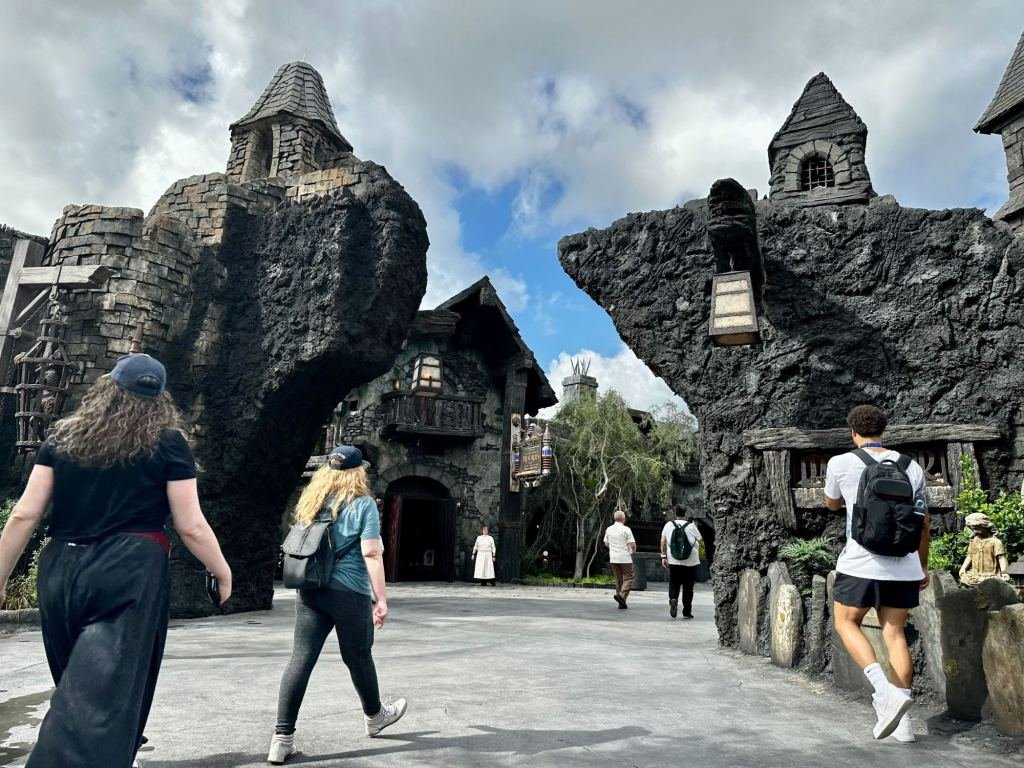Universal Epic Universe Visitors Honor Movie History with Flowers at a Grave Marker
In the shadow of daring roller coasters and immersive lands at the newly inaugurated $7 billion Universal Epic Universe in Orlando, Florida, visitors are engaging in an unexpected tribute: laying flowers at the grave marker of a fictional character—a little girl named Maria, unwitting victim of a tragic misunderstanding involving the Frankenstein monster. This poignant act intertwines nostalgia with grief, celebrating a storied cinematic past while inviting reflection on narratives that have long stirred emotions.
A Landmark Theme Park and Its Dark Odyssey
Since its official debut in late May, the Epic Universe has quickly made waves in the theme park landscape, showcasing over 50 rides, attractions, and experiences. However, it is the Dark Universe themed land that has sparked a profoundly human connection, as the statue of Maria—depicted gathering flowers—stands as a grave marker near the entrance. This not only serves as an Easter egg for dedicated fans of classic horror films but elevates the experience into one of shared remembrance.
Brandon Kleyla, Universal Creative Art Director, revealed in an Instagram post that he found the statue four years ago, instantly envisioning it as Maria’s grave marker. He stated, “Sitting in meetings, I always said that if the guests understand what we’re trying to do, there will be flowers on her grave on day one.” Kleyla expressed overwhelming emotion upon finding a flower at the grave on the park’s opening day, reinforcing the validation of his vision.
The Shadows of the Past
The character of Maria, a beloved yet mourned figure from the 1931 film Frankenstein, drowns after a fateful encounter with the misunderstood monster. For decades, her tragic fate was glossed over or omitted in discussions surrounding the film, rendering her story a footnote in horror lore. Censorship kept this scene hidden until the 1980s, when Universal restored the original film, allowing viewers to grapple with the emotional weight of the narrative.
According to Dr. Samantha Reyes, a cultural historian specializing in film studies, “Maria’s death is not merely an accident but rather a catalyst for discussions about innocence, misunderstanding, and monstrosity in horror cinema.” Reyes acknowledges that incorporating such a haunting piece of narrative history into the theme park enriches the visitor experience, allowing guests to engage with the complex emotions layered in these stories.
Incorporating Fan Tributes
Visitors to the Epic Universe have shown a surprising depth of appreciation for this homage, with many openly leaving flowers at the statue throughout the park’s previews and official opening. Anonymous fans and casual visitors alike have participated, some reportedly bringing handwritten notes. Universal’s initiative is seen not only as a nod to fans but as a profound reminder that these stories resonate beyond the screen.
- Emotional Resonance: The statue allows guests to engage with thematic elements that provoke reflection on loss and innocence.
- Cinematic Legacy: This tribute embodies the lasting impact of classic horror cinema on cultural narratives.
- Community Engagement: Visitors feel a connection not only with the story but with one another, fostering a shared experience.
“The fact that visitors are taking time to honor Maria reflects a significant emotional investment in the stories that Universal’s legacy represents,” adds film critic David Turner, an expert in the evolution of genre film. Turner suggests that such tributes underline a cultural phenomenon wherein audiences find connections to historical narratives through modern attractions.
The Impact of Dark Universe
The incorporation of Maria’s story may well serve a dual purpose. Not only does it preserve the memory of a character whose life was cut tragically short, but it also invites discussions about the moral implications of storytelling—how narratives shape societal views on monstrosity, fear, and empathy. The Dark Universe themed land stands poised to encourage a next-generation appreciation of these intricacies, as expressed by Kleyla’s vision.
Moreover, varying guest interactions with the space suggest a thriving culture of remembrance, further amplified by social media. “It’s unclear just how long this has been going on, but it’s quite touching that so many people are already bringing flowers to the grave,” noted one article, exemplifying the modern-day interplay between theme parks and cultural memory.
Since Kleyla joined Universal after eight years at Walt Disney Imagineering, he has crafted narratives that resonate on emotional and aesthetic levels. His previous work, including projects like the Haunted Mansion, reflects a deep understanding of combining horror elements with an inviting atmosphere. “At the end of the day, we’re inviting guests into these spaces not just to play but to feel,” he noted in an interview.
A Legacy of Remembrance
As visitors to Universal Epic Universe continue to pay tribute to Maria, they participate in a broader narrative of legacy and memory in popular culture. It’s a testament to the enduring power of storytelling—how even in the most fantastical settings, emotions and recollections can surface in profound and unexpected ways. The evocative presence of a grave marker for a fictional character stirs not just nostalgia but empathy, allowing patrons to bridge the gap between past and present.
The flowers adorning Maria’s statue exemplify a shared reverence for storytelling, illuminating the multifaceted relationship between audiences and the narratives that inspire them. In celebrating her life—albeit a fictional one—visitors are reminded of the complexities and consequences of their beloved monsters’ tales, forging a deeper connection with the legacy of the genre.





